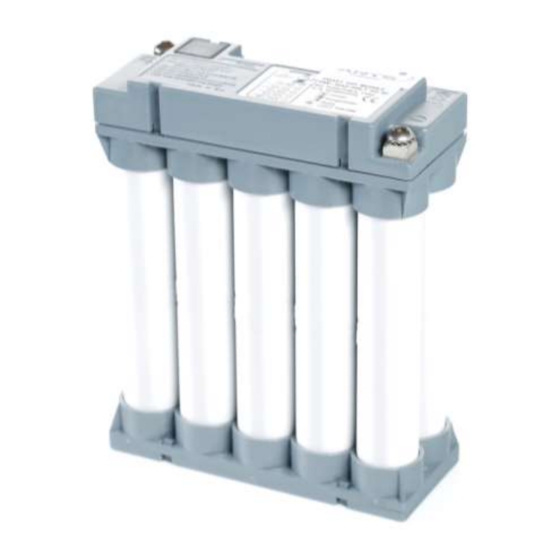
Table of Contents
Advertisement
Quick Links
Advertisement
Table of Contents

Summary of Contents for Arts Energy Smart Module
- Page 1 Smart Module User Manual Date: September 2016...
- Page 2 Main discharge pole (+) Fuses cover Specific connector (charge and communication) Gas Gauge LEDs & push button Status LED Main discharge pole (-)
- Page 3 AC network voltage. 2. Install the Smart Module by arranging the CCPS cord so that it is accessible to connect it to the module, but not too close so that heat generated from the CCPS will not be transferred to the battery.
-
Page 4: Charging The Battery
Charging the battery: When charging the battery, the charge status is indicated by the status LED: Orange Initialization phase / Fast charge: First check that the voltage > 0.8V/cell and the temperature within [-10°C;+40°C] If temperature > 50°C , charge duration will be longer ... -
Page 5: Using The Battery
This function allows recovering energy from a motor or a reversible device powered by the Smart Module. It is recommended to start to use the battery when the battery temperature is in the -10°C to +40°C range. - Page 6 If the Smart Module temperature reaches 65°C, the discharge is stopped by the control system to protect the battery. In this case the status LED will turn off and the gas gauge indicator will still indicate the real battery state of charge when pushing the button.
-
Page 7: Storage Recommendations
(main poles and charge pins on Specific charge and communication connector) and displays a defect signal on the status LED for one minute. If the defect disappears, the Smart Module can be restarted by pushing the gas gauge button. Flashing Defect, battery disconnected ... -
Page 8: Gas Gauge
Gas gauge: To check the available capacity left in the battery, press the push button. The 5-level display corresponds to the following state of charge: Battery Status Status Status Status Status state of charge 0%-10% 10%-30% 30%-50% 50%-80% 80%- 100% ... -
Page 9: State Of Health
State of health: The Smart Module includes a state of health (SOH) indicator that calculates the battery ageing and allows anticipating the end of life. To check the state of health of the battery, depress the push button for >2 seconds. - Page 10 CAUTION: NEVER • Immerse the battery or pour water on the battery. • Use improper CCPS to charge the battery. • Reverse charging of the battery. • Open battery outside of authorized network, disassemble the battery blocks or cells (be aware that alkaline electrolyte is contained inside, and electrolyte exposure can be harmful).
- Page 11 For 12 V and 24 V batteries, a 32V rated ATO fuse @15A for charge and @40A(Only for VH module) for discharge is required (Use a fuse @30A for a VHT Smart Module). • For 36 V batteries, a 58V rated fuse @15A for charge and @40A(Only for VH module) for discharge is required.
-
Page 12: Troubleshooting
TROUBLESHOOTING: THE BATTERY DOES NOT DELIVER CURRENT Possible causes Actions The battery is empty (pressing the “gas Charge the battery with the CCPS gauge” button results in blinking of the (charger). 0%-10% LED). The discharge fuse is blown. Check and replace the blown fuse. The “Key”... - Page 13 discharge at high current which caused automatically when the temperature of the temperature to rise above +40°C. the battery will be between -10°C and +40°C. The temperature of the battery is very The charge phase will start different from ambient temperature automatically when the temperature of (typically a cold battery such as 0°C the battery will be close to the...
- Page 14 battery connected to the charger during storage. THE BATTERY IS EMPTY BEFORE GAS GAUGE LEVEL ACTUALLY FALLS TO 0%-10% LEVEL (BLINKING RED) Possible cause Action The autonomy of the battery is reduced To do a calibration of the gas gauge to after repeated use of the battery.
-
Page 15: Personal Notes
PERSONAL NOTES... - Page 16 Published By ARTS Energy Information in this document is subject to change without notice and becomes contractual only after written confirmation by ARTS Energy __________________________ ARTS Energy 10 Rue Ampère- Zone industrielle 16440 Nersac Téléphone général : +33 (0)5 45 90 35 50...
- Page 17 www.arts-energy.com...
Need help?
Do you have a question about the Smart Module and is the answer not in the manual?
Questions and answers